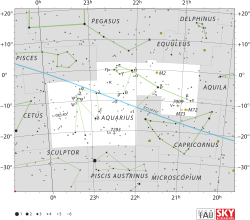Rho Aquarii
| Observation data Epoch J2000 Equinox J2000 | |
|---|---|
| Constellation | Aquarius |
| Right ascension | 22h 20m 11.91628s[1] |
| Declination | –07° 49′ 15.9649″[1] |
| Apparent magnitude (V) | +5.34[2] |
| Characteristics | |
| Spectral type | B8 IIIp Mn:Hg:[3] |
| U−B color index | –0.358[2] |
| B−V color index | –0.057[2] |
| Astrometry | |
| Radial velocity (Rv) | –9[4] km/s |
| Proper motion (μ) | RA: +14.75[1] mas/yr Dec.: +1.84[1] mas/yr |
| Parallax (π) | 3.70 ± 0.38 mas[1] |
| Distance | approx. 880 ly (approx. 270 pc) |
| Absolute magnitude (MV) | −1.78[5] |
| Details | |
| Mass | 5.00 ± 0.22[6] M☉ |
| Luminosity | 1,035[6] L☉ |
| Temperature | 12,593[7] K |
| Rotational velocity (v sin i) | 65[3] km/s |
| Other designations | |
| Database references | |
| SIMBAD | data |
Rho Aquarii, Latinized from ρ Aquarii, is the Bayer designation for a binary star in the equatorial constellation of Aquarius. It is visible to the naked eye with an apparent visual magnitude of +5.34.[2] Based upon parallax measurements made during the Hipparcos mission, this star is at a distance of roughly 880 light-years (270 parsecs) from Earth.[1]
This is a single-lined spectroscopic binary, with the presence of a companion being revealed by Doppler shifts in the spectrum.[7] The primary is a giant star with a stellar classification of B8 IIIp Mn:Hg:.[3] It is a Mercury-Manganese star, showing a surfeit of these elements in the spectrum.[7] With five times the Sun's mass, this star is radiating 1,035[6] times as much luminosity from its outer atmosphere at an effective temperature of 12,593 K.[7] This heat gives it the blue-white hue of a B-type star.[9] The companion may be a variable star.[10]
References
- ^ a b c d e f van Leeuwen, F. (November 2007), "Validation of the new Hipparcos reduction", Astronomy and Astrophysics, 474 (2): 653–664, arXiv:0708.1752, Bibcode:2007A&A...474..653V, doi:10.1051/0004-6361:20078357.
- ^ a b c d Cousins, A. W. J. (1984), "Standardization of Broadband Photometry of Equatorial Standards", South African Astronomical Observatory Circulars, 8: 59, Bibcode:1984SAAOC...8...59C.
- ^ a b c Abt, Helmut A.; Levato, Hugo; Grosso, Monica (July 2002), "Rotational Velocities of B Stars", The Astrophysical Journal, 573 (1): 359–365, Bibcode:2002ApJ...573..359A, doi:10.1086/340590.
- ^ Wilson, Ralph Elmer (1953), General Catalogue of Stellar Radial Velocities, Washington: Carnegie Institution of Washington, Bibcode:1953GCRV..C......0W.
- ^ Anderson, E.; Francis, Ch. (2012), "XHIP: An extended hipparcos compilation", Astronomy Letters, 38 (5): 331, arXiv:1108.4971, Bibcode:2012AstL...38..331A, doi:10.1134/S1063773712050015.
- ^ a b c Hohle, M. M.; Neuhäuser, R.; Schutz, B. F. (April 2010), "Masses and luminosities of O- and B-type stars and red supergiants", Astronomische Nachrichten, 331 (4): 349, arXiv:1003.2335, Bibcode:2010AN....331..349H, doi:10.1002/asna.200911355.
- ^ a b c d Makaganiuk, V.; et al. (January 2011), "The search for magnetic fields in mercury-manganese stars", Astronomy and Astrophysics, 525: A97, arXiv:1010.3931, Bibcode:2011A&A...525A..97M, doi:10.1051/0004-6361/201015666.
- ^ "* rho Aqr". SIMBAD. Centre de données astronomiques de Strasbourg. Retrieved 2012-07-04.
{{cite web}}: CS1 maint: postscript (link) - ^ "The Colour of Stars", Australia Telescope, Outreach and Education, Commonwealth Scientific and Industrial Research Organisation, December 21, 2004, retrieved 2012-01-16
- ^ Adelman, S. J.; Young, K. J. (January 2005), "uvby FCAPT photometry of the mCP stars HR 2258, MW Vul, and HR 9017 and the HgMn star 46 ρ Aqr", Astronomy and Astrophysics, 429: 317–322, Bibcode:2005A&A...429..317A, doi:10.1051/0004-6361:20041118.
External links
- HR 8512
- Image Rho Aquarii (in English)
- Aladin sky atlas, image (in English)

